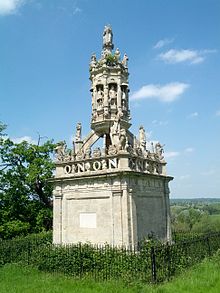Carfax Conduit
 From Wikipedia - Reading time: 3 min
From Wikipedia - Reading time: 3 min

The Carfax Conduit was a water conduit that supplied the city of Oxford with water from 1610 until 1869.
The conduit ran in an underground lead pipe from a spring on the hillside above the village of North Hinksey, beneath Seacourt Stream and the River Thames, to a building at Carfax in the centre of Oxford. The system was built by Otho Nicholson, a London lawyer, to supply the citizens of Oxford with clean water. It replaced a system built by Osney Abbey between 1205 and 1221 that had fallen into disrepair.[1]
The conduit building at Carfax was an elaborate structure, some 40 feet (12 m) tall, with eight niches containing statues of historic and mythical figures. By 1787 it had become an obstacle to traffic and it was removed in 1797 and replaced by a smaller cistern. The original structure was given to the Earl Harcourt, who had it re-erected in the grounds of his home, Nuneham House, where it remains to this day.[2] Two plaques are attached to opposite sides of the building, giving a short history in English and Latin.[3] The re-erected conduit is a Grade I listed building[4] and scheduled monument.[5]
A building, now called the Conduit House, was built at Harcourt Hill over the spring. It remains in situ and is in the care of English Heritage.[6] The Conduit House site is designated as a Grade II* listed building[7] and a scheduled monument.[8]
The entire system fell into disuse in the 19th century. In 1869, when it was carrying very little water, the conduit was sold to Oxford Corporation.[9]
Locations
[edit]
- Conduit House 51°44′31″N 1°17′03″W / 51.74194°N 1.28413°W
- Carfax 51°45′07″N 1°15′28″W / 51.7519°N 1.2579°W
- Cistern, now at Nuneham House 51°40′31″N 1°13′28″W / 51.6752°N 1.2244°W
Notes
[edit]- ^ Hanson, W.J. (1996) A Thousand Years: a study of the interaction between people and environment in the Cumnor, Wytham and North Hinksey Area Wytham Publications, p.22
- ^ Follies and Monuments website Archived 15 May 2008 at the Wayback Machine
- ^ Photograph of the English plaque
- ^ Historic England. "Carfax Conduit (Grade I) (1193569)". National Heritage List for England. Retrieved 12 January 2021.
- ^ Historic England. "Carfax Conduit, 540m south west of Nuneham House (1020965)". National Heritage List for England. Retrieved 12 January 2021.
- ^ English Heritage website
- ^ Historic England. "Well house, approximately 160 metres south east of The Fold (Grade II*) (1048315)". National Heritage List for England. Retrieved 12 January 2021.
- ^ Historic England. "North Hinksey conduit house (1015158)". National Heritage List for England. Retrieved 12 January 2021.
- ^ Victoria County History of Oxfordshire: Water Supply
References
[edit]- Hibbert, Christopher (ed.) (1988) The Encyclopaedia of Oxford; associate editor: Edward Hibbert. London: Macmillan ISBN 0-333-39917-X
- Cole, Catherine (1964–65). "Carfax Conduit" (PDF). Oxoniensia. 29–30: 142–166. Retrieved 21 July 2010.
 KSF
KSF